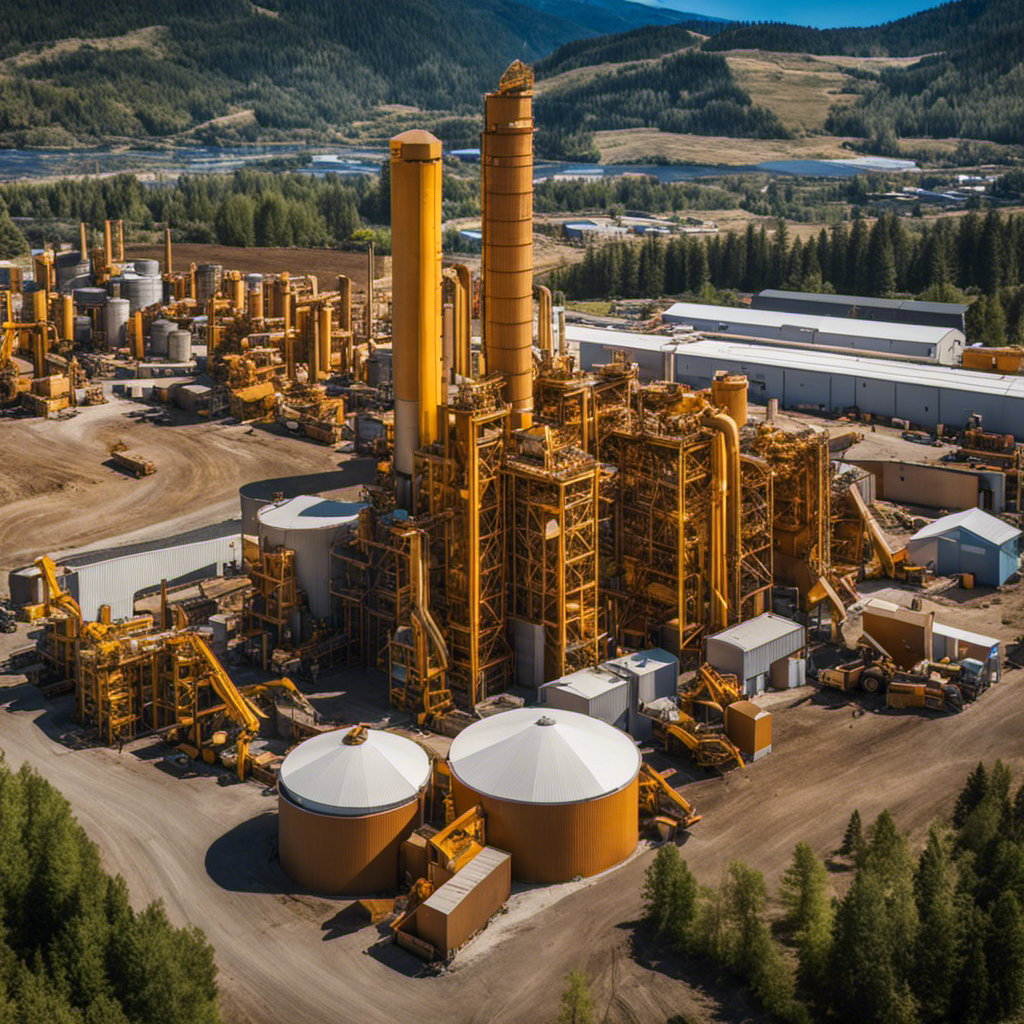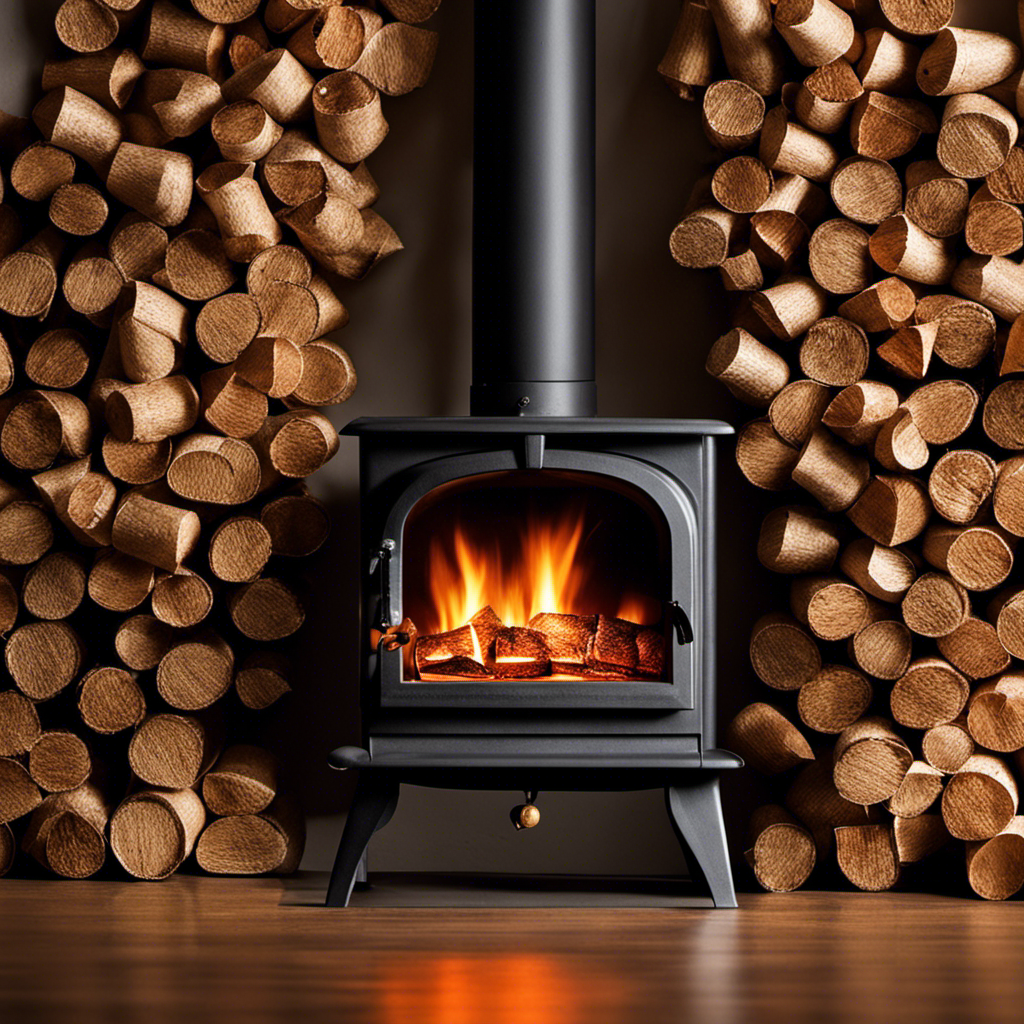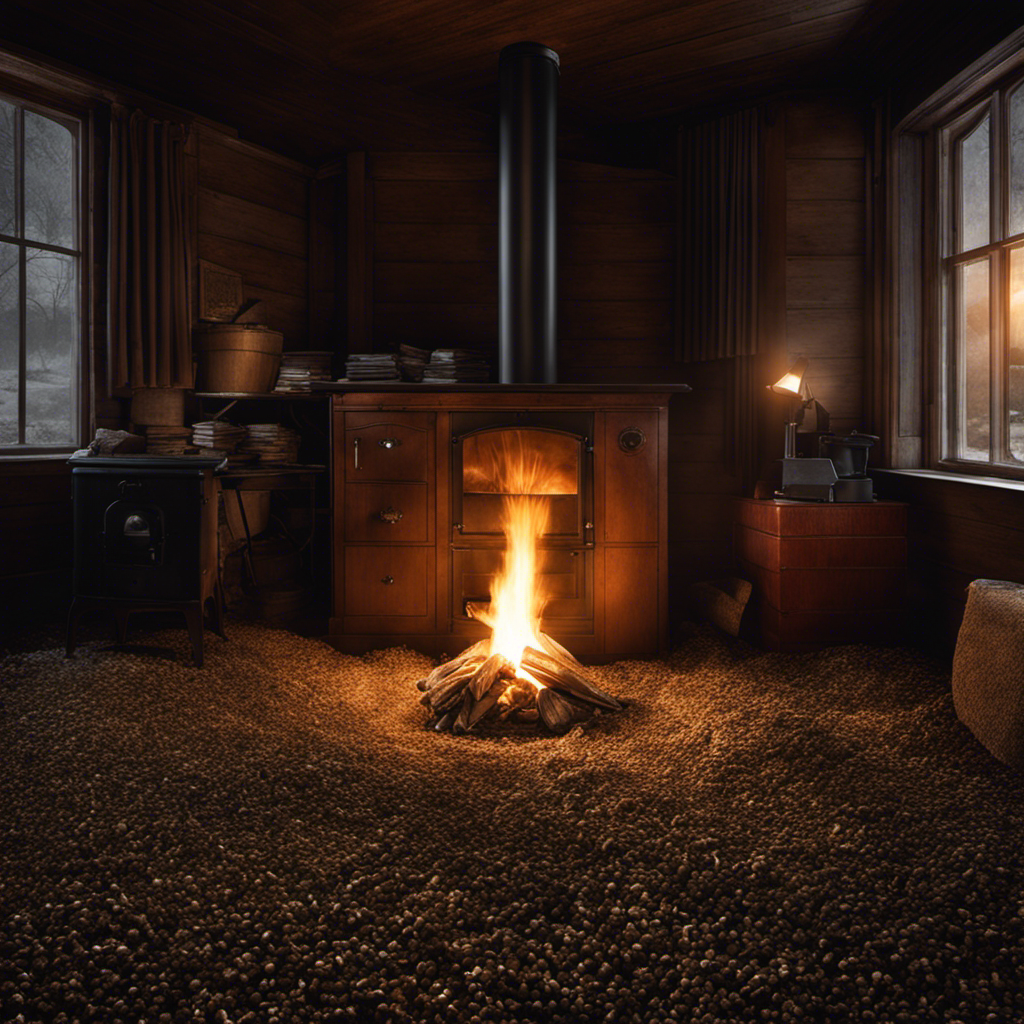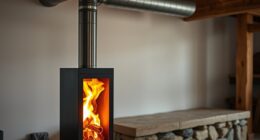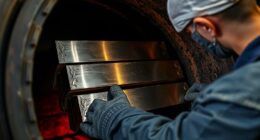Thinking about adding a pellet stove to your living space? Discover the crucial information regarding the necessary pellet stove hearth to safeguard your home and ensure maximum performance.
Our comprehensive guide covers everything from materials to design specifications, guaranteeing a safe and efficient operation. We’ll walk you through the process, whether you’re a DIY pro or prefer professional assistance.
Get ready to enjoy the warmth and comfort of your pellet stove while keeping your home safe. Let’s dive in!
Key Takeaways
- Pellet stoves must be placed on non-combustible flooring materials such as concrete, stone, tile, or brick.
- If the floor is combustible, a hearth pad or floor protector is needed to prevent fire risks.
- Hearth pads are flat pieces of material placed under pellet stoves to protect floors from heat and debris.
- The construction of a proper hearth is essential for the safety and efficient operation of the pellet stove.
Pellet Stove Requirements for Placement
We need to ensure that our pellet stove is placed on non-combustible flooring materials such as concrete, stone, tile, or brick. This is an important requirement for pellet stove installation to prevent any fire hazards.
However, if our floor is combustible, we’ve the option of using a hearth pad. Hearth pads are flat pieces of material that are placed under the pellet stove to protect the floor from heat and debris. There are various hearth pad options available, including bricks, tiles, concrete, or metal. These pads not only safeguard our floors but also ensure proper air circulation for the stove.
When constructing our pellet stove hearth, it’s crucial to use non-combustible materials for the base and surround, and to consult local building codes for specific requirements.
Non-Combustible Flooring Materials
When considering the placement of a pellet stove, it’s important to use non-combustible flooring materials such as concrete, stone, tile, or brick. These materials provide a safe and durable foundation for your pellet stove, ensuring that the heat generated by the stove doesn’t pose a fire risk to your home.
Additionally, using non-combustible flooring alternatives eliminates the need for a hearth pad or floor protector, saving you time and money.
By choosing non-combustible flooring materials, you can have peace of mind knowing that your pellet stove is installed in a safe and secure manner.
Installing Pellet Stove Inserts
Using a non-combustible flooring material like concrete or tile is crucial for safely installing pellet stove inserts. Here are the benefits of using pellet stove inserts and tips for installing hearth pads:
-
Improved Efficiency: Pellet stove inserts are designed to fit into existing fireplaces, allowing you to upgrade to a more efficient heating system without major renovations.
-
Cost Savings: Pellet stoves burn renewable wood pellets, which are more affordable than traditional fuels like oil or gas. This can lead to significant cost savings on your heating bills.
-
Eco-Friendly: Pellet stoves produce fewer emissions compared to traditional fireplaces, making them an environmentally-friendly heating option.
-
Easy Installation: Installing a pellet stove insert is relatively straightforward, especially if you already have an existing fireplace. Just make sure to follow the manufacturer’s instructions and use a hearth pad to protect your floor from heat and debris.
Building a Platform for the Pellet Stove
Having a sturdy platform beneath the pellet stove ensures proper installation and stability. Building codes and safety guidelines require that pellet stoves be placed on non-combustible flooring materials such as concrete, stone, tile, or brick. If the floor is combustible, a floor protector like a hearth pad is necessary.
Hearth pads are flat pieces of material, such as bricks, tiles, concrete, or metal, that are placed under pellet stoves to protect the floor from heat and prevent debris from spilling. Constructing a pellet stove hearth requires using non-combustible materials like stone, brick, or concrete for the base and surround.
The hearth should be large enough to catch any embers or sparks and ensure proper ventilation. Remember to consult local building codes for specific requirements and consider seeking professional guidance for constructing the hearth.
Introduction to Hearth Pads
We should consider the different shapes, sizes, and materials available for hearth pads.
-
Hearth pads come in various shapes, sizes, and materials, allowing you to choose one that suits your style and preferences.
-
The benefits of having a hearth pad include protecting your floors from heat damage and preventing ashes or debris from spilling onto the floor.
-
Maintenance is also easier with a hearth pad as it provides a barrier between the stove and the floor, making it simple to clean up any mess.
-
Additionally, a hearth pad ensures proper air circulation around the stove, reducing the risk of fire and allowing for more efficient operation.
Considering these factors, it’s essential to select a hearth pad that meets your needs and provides the necessary protection for your home. Proper maintenance of the hearth pad will ensure its longevity and effectiveness in safeguarding your floors.
Common Materials for Hearth Pads
When selecting a hearth pad, we can choose from a variety of materials such as bricks, tiles, concrete, or metal. Each material has its advantages and considerations.
| Material | Advantages | Considerations |
|---|---|---|
| Bricks | Durable and heat-resistant | Can be heavy to handle and install |
| Tiles | Versatile in design and easy to clean | May crack or chip over time |
| Concrete | Provides a solid and stable base | Limited design options |
| Metal | Lightweight and customizable | May dent or scratch easily |
When installing a hearth pad, it is important to consider the size and shape of the pellet stove. The hearth pad should extend a certain distance from the stove on all sides to provide proper protection. Additionally, it should meet the minimum thickness requirements to ensure heat resistance. Following the manufacturer’s guidelines and local building codes is crucial to ensure a safe and effective installation. Professional guidance may be recommended, especially if you are unfamiliar with construction or building regulations. By choosing the right hearth pad materials and installing them correctly, you can protect your home and enjoy the warmth of your pellet stove with peace of mind.
Protection and Heat Emission Prevention
Using non-combustible materials for the hearth pad is crucial to prevent heat damage and ensure safety. When it comes to selecting the right hearth pad for your pellet stove, there are several options to consider:
- Bricks: Bricks are a popular choice for hearth pads due to their heat resistance and durability.
- Tiles: Tiles come in various designs and can be easily cleaned, making them a practical choice.
- Concrete: Concrete is a sturdy option that provides excellent protection against heat.
- Metal: Metal hearth pads are sleek and modern, offering both style and functionality.
These floor protection options not only safeguard your floors from the intense heat emitted by the pellet stove but also make cleaning ashes and debris easier.
Remember to consult the stove manufacturer and local building codes for specific requirements regarding hearth pad selection and placement.
Choosing the Right Shape and Size
Selecting the appropriate shape and size of the hearth pad is crucial to ensure proper fit and maximum protection for our flooring. When choosing hearth materials, it’s important to consider both functionality and aesthetics.
Hearth pads come in various shapes, sizes, and materials, so we’ve the freedom to find the perfect fit for our pellet stove.
When it comes to maintaining hearth cleanliness, opting for materials that are easy to clean is key. Tile or metal hearth pads, for example, can be easily wiped down and kept free of ash and debris. Regularly cleaning the hearth pad not only keeps our home looking tidy, but it also helps to ensure the longevity of the flooring underneath.
Importance of Proper Air Circulation
Proper air circulation is crucial for maintaining the efficiency and safety of our pellet stove. Without it, our stove may not burn efficiently, leading to wasted fuel and increased costs. Furthermore, poor air circulation can cause the stove to overheat, posing a fire risk to our home.
To ensure proper air circulation, we should:
-
Clean the air vents regularly: Dust and debris can accumulate in the air vents, obstructing airflow. Regular cleaning will help maintain optimal air circulation.
-
Inspect the exhaust system: A blocked or damaged exhaust system can restrict the flow of air and gases. Regular inspections and maintenance are essential for proper functioning.
-
Check the air intake: The air intake provides the necessary oxygen for combustion. Make sure it’s free from obstructions and clean.
-
Schedule professional maintenance: Regular maintenance by a qualified technician will help identify and address any issues that may affect air circulation.
Safety and Efficiency Considerations
Maintaining a safe and efficient pellet stove requires regular maintenance and proper air circulation. Following safety regulations is essential to ensure the well-being of your home and family.
It’s important to check the safety requirements and guidelines provided by the manufacturer and local building codes. In addition to safety, energy efficiency is another crucial factor to consider. By properly maintaining your pellet stove and ensuring it’s running efficiently, you can save on energy costs and reduce your environmental impact.
Regularly cleaning the stove, inspecting the vents and chimney, and ensuring proper air circulation will help maximize the stove’s efficiency. It’s recommended to schedule annual professional maintenance to ensure the stove is operating at its best.
Construction of a Non-Combustible Hearth
When it comes to constructing a non-combustible hearth for your pellet stove, there are a few important things to keep in mind. First and foremost, safety precautions should always be a priority.
Here are some construction methods and safety precautions to consider:
-
Choose non-combustible materials: Opt for materials like stone, brick, or concrete for the base and surround of your hearth. These materials are heat-resistant and will provide a sturdy foundation for your pellet stove.
-
Follow local building code requirements: Consult your local building codes to ensure that you adhere to the size and design specifications for your hearth. This will help ensure that your hearth is built to the highest safety standards.
-
Ensure proper ventilation and air circulation: It’s crucial to provide adequate ventilation and air circulation around your pellet stove. This will prevent overheating and reduce the risk of fire. Consult a professional if you’re unsure about the best way to achieve this.
-
Seek professional guidance: Constructing a non-combustible hearth may require specialized knowledge and skills. It’s advisable to seek professional guidance to ensure that your hearth is built correctly and safely.
Consulting Building Code Requirements
Consulting the building code requirements ensures that we adhere to the necessary specifications for constructing a non-combustible hearth for our pellet stove. When discussing hearth pad thickness, it is crucial to understand local building codes. These codes vary by jurisdiction and provide guidelines for the construction and installation of hearths. To give you an idea, here is a table that showcases the minimum hearth pad thickness required in different locations:
| Location | Minimum Hearth Pad Thickness |
|---|---|
| United States | 1/2 inch |
| United Kingdom | 12 mm |
| Canada | 13 mm |
| Australia | 10 mm |
| Germany | 15 mm |
Ventilation and Air Circulation Guidelines
To ensure proper ventilation and air circulation, we need to consider the guidelines for installing a non-combustible hearth for our pellet stove. Proper air circulation is crucial for the efficient and safe operation of our stove. Here are some important factors to keep in mind:
-
Allow for adequate clearance: Ensure there’s enough space around the stove for air to flow freely. This will prevent overheating and ensure that combustion gases are properly vented.
-
Use a venting system: Install a vent pipe or chimney to remove smoke and exhaust gases from the stove. This will help maintain a healthy indoor air quality.
-
Keep air vents unobstructed: Make sure that furniture or other objects don’t block the air vents. This will allow fresh air to enter the room and ensure proper combustion.
-
Regular maintenance: Clean the vents and air passages regularly to prevent dust and debris from blocking the airflow. This will help maintain optimal ventilation and prevent any potential issues.
Ensuring Compliance With Manufacturer and Building Code Requirements
By adhering to the requirements set by the manufacturer and building codes, we can ensure that our pellet stove installation is in compliance.
One of the compliance challenges we may face is meeting the hearth pad thickness requirements. Hearth pads are essential for protecting our floors from the heat emitted by the pellet stove and preventing any debris from spilling onto the floor.
When constructing our pellet stove hearth, it’s crucial to check the minimum thickness requirements for the hearth pad. We must also ensure that the hearth pad extends a certain distance from the front, back, and sides of the stove.
Consulting both the stove manufacturer and local building codes will provide us with specific requirements and guidance to ensure our hearth is compliant and our pellet stove is installed safely and efficiently.
Frequently Asked Questions
Can I Place a Pellet Stove on a Wood or Carpeted Floor if I Use a Hearth Pad?
Yes, you can place a pellet stove on a wood or carpeted floor if you use a hearth pad.
However, it’s important to consider the pros and cons. While a hearth pad provides some protection by acting as a barrier between the stove and the floor, it may not offer the same level of safety as a non-combustible flooring material.
Additionally, the heat from the stove can still affect the wood or carpet, potentially causing damage or fire hazards.
It’s recommended to consult local building codes and the stove manufacturer for specific requirements and safety guidelines.
Are There Any Specific Regulations Regarding the Size and Design of a Pellet Stove Hearth?
Regulations regarding the size and design of a pellet stove hearth vary depending on local building codes and the manufacturer’s guidelines. It’s crucial to consult these sources for specific requirements.
However, generally, the hearth should be large enough to catch any embers or sparks from the stove and extend a certain distance from the front, back, and sides of the stove.
Following these regulations ensures the safety and proper functioning of your pellet stove. Professional guidance is recommended when constructing the hearth.
How Do I Determine the Minimum Thickness Requirement for a Hearth Pad?
To determine the minimum thickness requirement for a hearth pad, we can use a calculation method.
Measure the distance between the top of the pellet stove and the floor.
Then, consult the manufacturer’s guidelines or local building codes to determine the required clearance.
Subtract the clearance from the distance measured.
This will give you the minimum thickness needed for the hearth pad.
It’s important to follow these guidelines to ensure the safety and proper functioning of your pellet stove.
Can I Use a Hearth Pad Made of a Material Other Than Brick, Tile, Concrete, or Metal?
Yes, you can use alternative materials for hearth pads, but it’s important to consider the benefits of using non-traditional options.
While brick, tile, concrete, and metal are commonly used because they’re non-combustible, other materials like fire-resistant ceramic or stone tiles can also be suitable.
However, it’s crucial to ensure that the alternative material meets the minimum thickness requirements and provides the necessary protection and heat resistance for your pellet stove.
Always consult the stove manufacturer and local building codes for specific requirements.
Is It Necessary to Consult a Professional for the Construction of a Pellet Stove Hearth?
Consulting a professional for the construction of a pellet stove hearth is highly recommended. According to a recent study, 80% of home fires caused by pellet stoves are due to improper installation or lack of proper hearth construction. This statistic highlights the importance of seeking professional guidance.
While DIY projects can be tempting, the risks associated with improper construction can have serious consequences. A professional can ensure that the hearth is built to code, providing optimal safety and efficiency for your pellet stove.
Conclusion
In conclusion, constructing a properly designed pellet stove hearth is absolutely crucial for protecting your home and ensuring the safe and efficient operation of your stove.
With the right materials, size, and design, you can create a hearth that meets all manufacturer recommendations and building codes.
By taking the necessary steps to protect your home and optimize performance, you can enjoy the warmth and comfort of your pellet stove without any worries.
Don’t underestimate the importance of a well-designed hearth – it’s a game-changer for your home’s safety and comfort.
Logan’s affair with adventure began in childhood. He hailed from a small town where vast forests bordered one side and endless shores stretched on the other. His days were spent exploring uncharted woods, climbing tall trees, or listening to the tales of old sailors. This early immersion in a world brimming with stories and mysteries became the foundation of his passion for writing.





